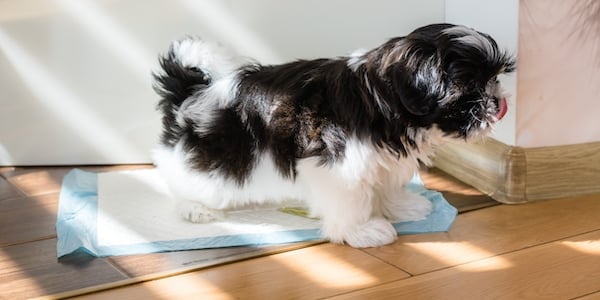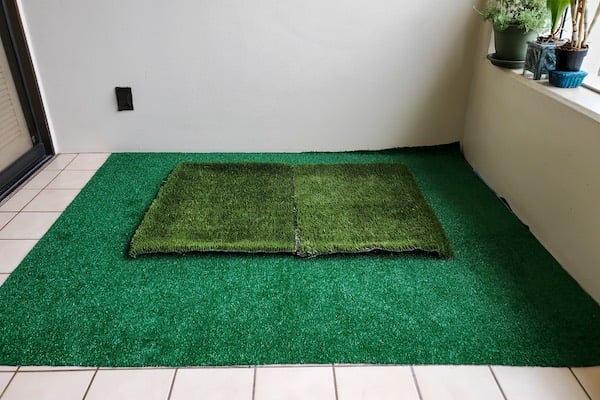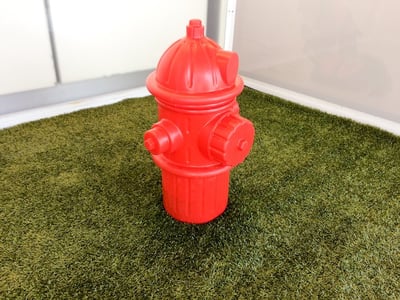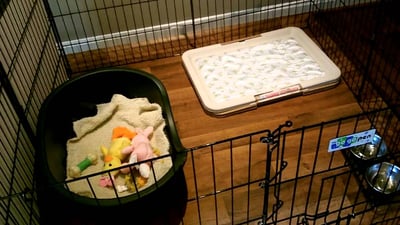 Using potty pads for your dog has its pros and cons. While they can be incredibly useful for a variety of reasons, perhaps the most frustrating aspect of using potty pads is when your puppy or adult dog just can’t seem to get their aim right and miss the pad.
Using potty pads for your dog has its pros and cons. While they can be incredibly useful for a variety of reasons, perhaps the most frustrating aspect of using potty pads is when your puppy or adult dog just can’t seem to get their aim right and miss the pad.
Your dog may go potty right next to their pad. Maybe they're half-on and half-off ... and the urine leaks out onto your floor. Or perhaps your male dog goes to their pad but then lifts his leg and ends up marking on the wall or a piece of furniture. Pee splatter everywhere!
If you’re struggling with getting your dog to pee on the pad rather than the floor or wall, I’ve got some ideas for you.
If your dog was previously using their potty pads without missing and is suddenly having accidents off their pad, it’s important to have them checked out by their veterinarian. In some cases, medical issues such as urinary tract infections can be the cause.
How to Fix Your Dog Missing the Potty Pad
Location, Location, Location
Think about where the pad is located. Set your dog up for success with where you’ve placed the potty pad, so they are more likely to use it correctly.
- Avoid busy areas. Choose a quiet place for your dog’s indoor potty spot where they won’t get distracted and potentially wander off their pad in the middle of their business.
- Make sure the pad is away from where they eat, drink, and sleep. If you're using a potty pad in your puppy’s playpen area, simply put the pad at the opposite side of the pen, as far away as possible from their bowls and bed.
- Is the pad location easy for your dog to access? This is especially important for senior dogs who may have more mobility issues going up and down stairs to get to their pad. Puppies still working on housetraining may not be able to hold it long enough to reach their pad area if it's not close by. If needed, place a pad on each level of your home.
- Avoid close corners or “blocked in” areas. If your dog’s pad is too close to the wall or blocked in by furniture, they are less likely to get all the way on it before going to the bathroom. Make sure there is plenty of open space (ideally on at least three sides of the pad) or the pad is pulled back from the wall, so they don’t feel cramped.

Use the Right Size of Potty Pad
If you have a larger dog, make sure to use the larger potty pad sizes so they don’t accidentally soil just off the edges. You may even need to use two pads right next to each other to ensure they have enough surface area.
Keep the Potty Pad Clean
Many dogs won’t want to walk on their pad if it is already soiled. Plus, you don't want them tracking little pee paw prints off the pad and onto your floor! Change out the pad after every use.
 Create a Vertical Potty Spot for Male Dogs
Create a Vertical Potty Spot for Male Dogs
For male dogs who lift their leg while urinating, it can be helpful to place a vertical surface for them to aim for in the center of their pad. This could be a cone or you can get fancy and set up their own personal potty training fire hydrant (here's a small plastic hydrant one and another made out of stone and resin). This way, they have a particular place to lift their leg and aim for, saving your walls or furniture.
If your dog has a particularly “strong” stream that splatters, consider attaching a pad to the wall or surface there to protect your home and make clean-up easy. There are even pee baffles (vertical boards that block the wall surface) or magnetic pad holders that you can place to hold the pad up against the wall. If you think your dog will be inclined to gnaw the magnet holders off the wall, it's best to avoid this option, as magnets are dangerous if eaten.
Another option is using a real-grass indoor potty pad, like the Fresh Patch, which is much more absorbent than a regular pad, lessening any splattering when they urinate on it.
Use a Litter Box or Potty Pad Holder

You can create a more obvious edge to your dog’s potty pads by using a litter box (for small dogs) or a potty pad holder tray (for all sizes). This way, your dog has an easier time knowing the difference between your floor and the potty area because the edge surface is raised.
Senior dogs may appreciate a pad holder, especially if they have mobility issues and the pad slips when placed on hard floors or tiles. You can increase their confidence by making sure the pad doesn't slip when they walk on it.
Plus, if you use a holder tray for your dog's pads, it's not as easy for them to grab them and chew them up. For puppy playpens, trays also prevent your pup from rolling toys into their potty area as easily.
Train Your Dog to Only Go Potty Outside
Perhaps the most straightforward solution is to stop using potty pads. This option might work for you, but if you live in an apartment or don't have easy access to a designated outdoor potty spot, it might not be possible. If you do want your dog to only go potty outside, you'll need to transition them away from potty pads altogether. This process takes time and patience.
Clean Up Accidents & Revisit Potty Training
Make sure to thoroughly clean potty accidents and the areas around the potty pad area. The smell of urine attracts dogs to go in the same area, so it’s crucial to use an enzymatic cleaner to remove that scent.
If your dog is missing the pad by a wide margin or has lots of accidents, you may need to go back to the first steps of potty training to reinforce the correct potty area. They may never have quite learned where they are supposed to go and need a refresher. And if you have a puppy, it’s important to be patient when first potty training! They often miss the pad simply because they’re just learning and need more practice. Most puppies aren't consistently potty trained until around 6 months old (sometimes longer for the smaller breeds).
Does your dog miss their potty pad? Share with us what you've done to fix it in the comments below!



